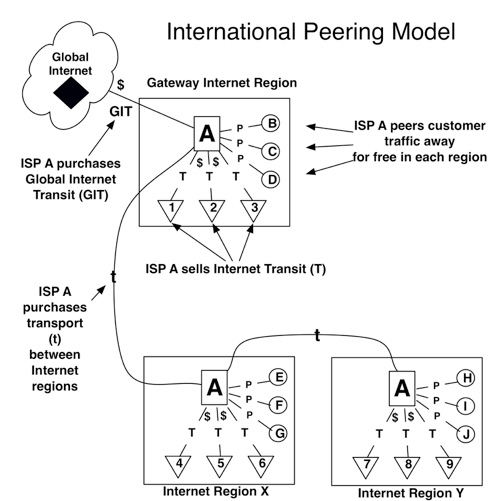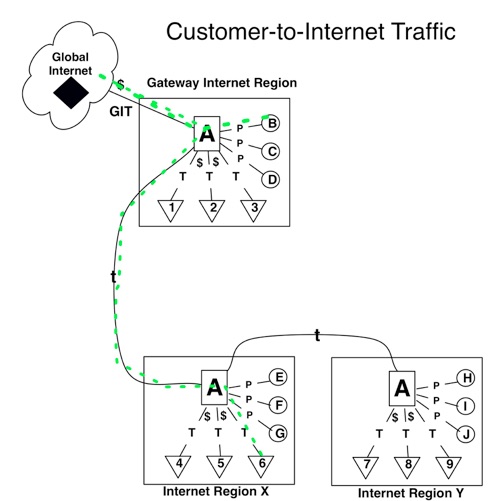Ask Dr. Peering




Q:
DrPeering –
How should we think about expanding our peering and network footprint internationally?
Harry Zimm
Chili Palmer
Zimm Productions
A:
Harry -
At the end of every Internet Peering Workshop we end up at the same discussion; How should we think about our international peering strategy? Here I will share a simple framework that has proven helpful for creating an international peering strategy.
An International Peering Model
We will build our model by making some simplifying assumptions.
First, we will continue our naming convention and call our model ISP “ISP A.” We assume that ISP A is interested in interconnecting in three Internet Regions, with one of these regions being a “gateway” Internet Region where Internet Transit is inexpensive. The other Internet Regions will be called “Internet Region X” and “Internet Region Y.” Let’s assume that ISP A has a single router (shown as ‘A’ in the figure) in each region providing interconnections for that region. These routers are interconnected across transport circuits ‘t’ as shown in Figure 14-1.

Figure 14-1. The Basic International Interconnect Model
Interconnections in Each Internet Region
In each Internet Region we assume that ISP A establishes a Point-of-Presence (POP) to interconnect with others in
1.free and reciprocal peering relationships (shown as ‘P’ in the figure), or in
2.transit relationships (shown as ‘T’ with a ‘$” highlighting which side gets paid).
Transit customers are numbered and the peers are lettered so we can discuss traffic flows and corresponding revenue flows. We will refer to this diagram throughout the rest of the chapter.
Assumptions: Customers, Revenue, and Costs of Traffic Flow
In creating the peering model for discussions, we will hold five peering variables constant.
1) Customers. All customers are assumed to be homogeneous. All customers offer the same traffic load, and they are all entirely content-heavy or access-heavy. Therefore, all traffic travels in the dominant direction. These assumptions simplify the revenue arithmetic and allow us to ignore peering ratios issues.
2) Revenue. We are making the simplifying assumption that all customers of ISP A pay the same price ($T/Mbps) for Internet Transit. As is standard practice, Internet Transit is metered and customers pay only for traffic in the dominant direction. We further simplify the math by assuming that all customers are colocated at the ISP A colocation center of choice, so customers of ISP incur no transport costs when they buy access to the Internet from ISP A.
3) Inter-Regional Transport Cost. Each of ISP A’s POPs are interconnected using international transport, shown as ‘t’ in figure 14-1. We will assume that all inter-regional transport has an average cost of $t/Mbps. (Note that ISPs that own their own cable will see this as a ‘sunk’ cost and therefore $t = $0/Mbps.)
4) Peering Costs. We assume that all of ISP A peers are located at ISP A’s colocation center so there are no peering costs. Cross-connect fees, peering port fees, colocation fees are assumed to be free or included in their existing presence. For the same reason, we are assuming no incremental cost for peering equipment.
5) Global Internet Transit. We will assume that ISP A can purchase access to the rest of the Internet inexpensively ($GIT/Mbps) in the “Gateway” Internet Region.
These simplifying assumptions help us create a base model for discussion and ultimately help us articulate an international peering strategy. It is a valuable exercise then to challenge each assumption and refine the model to take these into account.
Our experience has been that these early discussions tend to go a long way towards articulating a coherent international peering strategy.
Now that we have introduced the international peering model, let’s talk about traffic flows and calculate the corresponding costs and revenue flows.
Traffic Flows
There are only three categories of traffic to be considered when looking at ISP A’s interconnect strategy:
1.Customer-to-customer traffic (also called “customer routes”), and
2.Customer-to-peer’s-customer-traffic (also called “peer routes”),
3.Customer-to-the-rest-of-the-Internet-traffic (also called “default route”).
Let’s consider each category of traffic flow.
1) Customer-to-Customer traffic
Traffic between ISP A customers and other ISP A customers will be exchanged within an Internet Region or between Internet Regions. For example, customer #9 may send content to customer #8, or customer #6 may send traffic to customer #7 as shown in Figure 14-2.

Figure 14-2. Model of traffic flow between ISP A's customers and other ISP A customers
Notes from the Field.
Level 3 Acquires Eyeball and Content Customers
It is worth noting that acquiring both content customers and eyeball customers is a common interconnection strategy. The ISP “Level 3” for example courted cable companies while simultaneously courting the largest content customers that wanted their content as topologically close to the eyeballs as possible. By satisfying both customers entirely across the Level 3 network, they collect money from both sides. Eyeball networks pay for the traffic the users download and the content companies pay for the traffic that they push across the Internet. This strategy also increases the value of the network, and therefore makes it easier to peer and acquire additional customers. Selling to traffic sources and sinks demonstrates what economists call a “two-sided market.”
Revenue. For this type of traffic, ISP A receives revenue of 2 * $T/Mbps. If traffic has to go between Internet Regions, there may be a cost of $t/Mbps. As a result, for this type of traffic we see that ISP A obtains revenue from customer-to-customer traffic flow of
C-C Revenue = 2*$T/Mbps - $t/Mbps
2) Customer-to-Peer’s-Customer traffic
The second type of traffic is customer traffic that is destined to or coming from a peer’s customer. In this case, as shown in figure 14-2, traffic between ISP A’s customers and its peers’ customers will either be satisfied within the country (such as Peer J sending content to customer #7) or satisfied by sending traffic between Internet Regions (such as Peer B sending traffic to customer #6.)

Figure 14-2 - Model of Internet traffic flow between ISP A's customers and its peer's customers
Revenue. In either case, ISP A collects revenue of $T/Mbps from its customers. Customers #6 and #7 pay ISP A for the traffic that is ultimately going to or coming from ISP A’s peers. If traffic has to go between Internet Regions, ISP A may bear an additional transport cost of $t/Mbps.
As a result, for this type of traffic we see that ISP A obtains revenue from customer-to-peer traffic flow of
C-P Revenue = $T/Mbps - $t/Mbps
3) Customer-to-Internet traffic
Traffic that can’t be satisfied between ISP A customers, and can’t be satisfied with ISP A’s peers, is ultimately delivered via ISP A’s upstream transit provider in the Gateway Internet Region.

Figure 14-4 - Model of traffic flow between ISP A's customers and the rest of the Internet.
Revenue. For this type of traffic, ISP A receives revenue of $T/Mbps but pays transit fees of $GIT/Mbps. If traffic has to go between Internet Regions, there may be a cost of $t/Mbps.
As a result, for this type of traffic we see that ISP A obtains revenue from customer-to-Internet traffic flow of
C-I Revenue = $T/Mbps - $GIT/Mbps - $t/Mbps
Traffic Flow and Revenue Summary
The key point is, with all three types of traffic customer traffic generates revenue for ISP A. As long as transit revenue exceeds traffic exchange costs, ISP A will derive incremental revenue from customer traffic.

Figure 14-5. Customer traffic generates incremental revenue.
We have discussed the three traffic types and corresponding revenue. Next month we will exercise the model with a couple of peering and transit strategies for building into an emerging Internet Peering Ecosystems and why open peering is a sound strategy in new markets.

In this article we present a simple model for International Peering.
(This is an excerpt from the upcoming 2013 Edition of The Internet Peering Playbook.)
An International Peering Model (Part 1 of 2)
March 20, 2013

The 2014 Internet Peering Playbook
In Print
and for the Kindle:
The PDF, ePub and
.mobi files are
also available as a
perpetually updated
DropBox share:
Price: $9.99
and in French!
The 2013 Internet Peering Playbook
also available for the Kindle:
and the ipad






